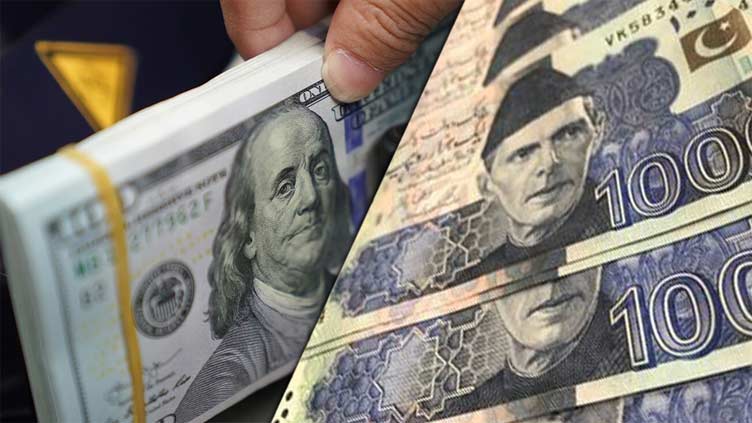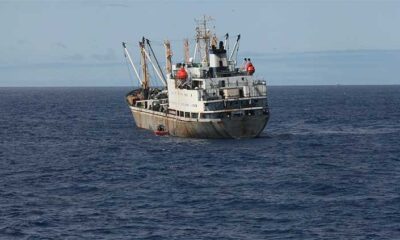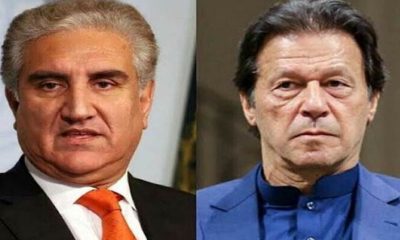Despite macroeconomic challenges and slow progress of fiscal indicators, there is a glimmer of hope for improvement as the Pakistani rupee showcases remarkable resilience against the US dollar, which experts believe would have positive impact on national economy.
On September 6, the caretaker government announced launching a massive crackdown against the elements involved in dollar smuggling, hoarding and organized crime cartels, causing loss to the national economy.
By adopting a ‘zero-tolerance’ stance towards the smuggling and hoarding, Pakistani rupee started gaining against the dollar and since September 5 it witnessed around Rs 24.41 appreciation and Rs 282.68 in interbank trading during 22 consecutive recovery sessions, as of October 6.
In line with its strategy, the government has also planned prize money (cash reward) for those citizens who would provide information leading to the identification of elements involved in the smuggling and hoarding.
For this purpose, a toll-free number has been set up at the Federal Investigation Agency (FIA) and the Ministry of Interior to call and share the required information against the elements involved in illegal activities, causing a dent in the national economy.
Official sources told APP that strict action was being taken after the identification of facilitators and patrons of government officials indulged in illegal economic activities. They said complete lists of the elements involved in illegal economic activities were ready; and accordingly, an extensive crackdown was underway.
The sources said the main reason to initiate and enforce administrative measures against hoarders, black marketers, and dollar smugglers were the constant devaluation of the rupee against the US dollar.
They said the government had ordered to take strict action against unauthorized money changers and other mafias operating in the country. “Major policy reforms are underway. Commodity/currency trading will be changed.”
Whereas, the sources said surveillance systems were being upgraded at land, sea and airports, adding “Illegal movement of goods and currency will not be allowed.”
On September 5, the rupee against the dollar in the interbank trading was at Rs 307.09 and by October 6 it came down to Rs 282.68, price of the Euro declined to Rs 298.03 from Rs 330.13, British Pound to Rs 344.73 from Rs 385.22, Emirate Dirham to Rs 76.96 from Rs 83.60 and Saudi Riyal to Rs 75.37 from Rs 81.87.
Whereas the buying and selling of the dollar in the open market came down from Rs 320.8 to Rs 280 and Rs 324 to Rs 282.75 respectively.
Experts believe that all economic indicators would start moving in the right direction once the Pakistani currency got its real worth, strength and stability.
Federal Minister for Finance, Revenue, Economic Affairs and Privatization Dr Shamshad Akhtar said the foreign exchange reserves position was stable, adding that Exchange Companies Reform and anti-smuggling operations did stabilize the rupee.
“This stability came without any bank intervention.” She said that the measures being taken for the value of currency include strengthening the regulatory rules for exchange companies, along with the ongoing measures for smuggling and hoarding of foreign exchange because no country can allow playing with the currency.
Federal Minister for Commerce, Dr. Gohar Ejaz said that one of the causes of depreciation of Pakistani currency was smuggling of transit goods from Afghanistan to Pakistan which had risen from $4 billion to $6.7 billion.
He said, around $500 million that were earned by Pakistanis overseas was financing Afghan transit. He said, without any intervention by State Bank of Pakistan, the dollar went down to Rs 280 from Rs 330 due to government measures and crackdown on hundi-hawala set ups.
The appreciation of rupee was also acknowledged internationally as Bloomberg in a recent report said Pakistani currency was set to become the top performer globally in the last month (September).
“Many leakages were happening through illegal channels of hawala and hundi trade from the open market,” Khurram Schehzad, Chief Executive Officer of Alpha Beta Core Solutions Pvt. Ltd, a financial consultancy in Karachi told Bloomberg.
Talking to APP, General Secretary of the Exchange Companies Association of Pakistan (ECAP) Zafar Sultan Paracha confirmed that the crackdown against smugglers and hoarders of dollars had a “highly positive impact.”
“Pakistani rupee has witnessed a significant appreciation of around Rs 45 against the dollar due to government initiatives. Currently, the rupee stands at Rs 287, and the target is to bring it down to Rs250 to Rs260,” he remarked.
He mentioned that exchange companies were depositing approximately $30-40 million to banks on a daily basis. He pointed out that for the first time; the open market rates were lower than the interbank rates. Paracha said that several exporters, who had previously halted payments due to the significant gap between interbank and open market rates, have now resumed releasing the amounts.
He also highlighted that this trend is expected to continue in the coming days due to the increasing supply of dollars and decreasing demand. The gradual reduction of the significant gap between interbank and open market rates has encouraged overseas Pakistanis to utilize legal channels, such as banking, to transfer dollars to the country.
As a result, there has been a surge in daily remittance inflows. It should be noted that this trend would continue to persist in the coming days due to increasing supply and decreasing demand (of dollars),” he added. Muhammad Suhail, a noted economist observed that the winning streak of the rupee will depend on future economic fundamentals.
“In the short run, we may see the PKR strengthening due to ongoing measures taken by the regulators for compliance with laws,” he added.
Despite macroeconomic challenges and slow progress of fiscal indicators, there is a glimmer of hope for improvement as the Pakistani rupee showcases remarkable resilience against the US dollar, which experts believe would have positive impact on national economy.
On September 6, the caretaker government announced launching a massive crackdown against the elements involved in dollar smuggling, hoarding and organized crime cartels, causing loss to the national economy.
By adopting a ‘zero-tolerance’ stance towards the smuggling and hoarding, Pakistani rupee started gaining against the dollar and since September 5 it witnessed around Rs 24.41 appreciation and Rs 282.68 in interbank trading during 22 consecutive recovery sessions, as of October 6.
In line with its strategy, the government has also planned prize money (cash reward) for those citizens who would provide information leading to the identification of elements involved in the smuggling and hoarding.
For this purpose, a toll-free number has been set up at the Federal Investigation Agency (FIA) and the Ministry of Interior to call and share the required information against the elements involved in illegal activities, causing a dent in the national economy.
Official sources told APP that strict action was being taken after the identification of facilitators and patrons of government officials indulged in illegal economic activities. They said complete lists of the elements involved in illegal economic activities were ready; and accordingly, an extensive crackdown was underway.
The sources said the main reason to initiate and enforce administrative measures against hoarders, black marketers, and dollar smugglers were the constant devaluation of the rupee against the US dollar.
They said the government had ordered to take strict action against unauthorized money changers and other mafias operating in the country. “Major policy reforms are underway. Commodity/currency trading will be changed.”
Whereas, the sources said surveillance systems were being upgraded at land, sea and airports, adding “Illegal movement of goods and currency will not be allowed.”
On September 5, the rupee against the dollar in the interbank trading was at Rs 307.09 and by October 6 it came down to Rs 282.68, price of the Euro declined to Rs 298.03 from Rs 330.13, British Pound to Rs 344.73 from Rs 385.22, Emirate Dirham to Rs 76.96 from Rs 83.60 and Saudi Riyal to Rs 75.37 from Rs 81.87.
Whereas the buying and selling of the dollar in the open market came down from Rs 320.8 to Rs 280 and Rs 324 to Rs 282.75 respectively.
Experts believe that all economic indicators would start moving in the right direction once the Pakistani currency got its real worth, strength and stability.
Federal Minister for Finance, Revenue, Economic Affairs and Privatization Dr Shamshad Akhtar said the foreign exchange reserves position was stable, adding that Exchange Companies Reform and anti-smuggling operations did stabilize the rupee.
“This stability came without any bank intervention.” She said that the measures being taken for the value of currency include strengthening the regulatory rules for exchange companies, along with the ongoing measures for smuggling and hoarding of foreign exchange because no country can allow playing with the currency.
Federal Minister for Commerce, Dr. Gohar Ejaz said that one of the causes of depreciation of Pakistani currency was smuggling of transit goods from Afghanistan to Pakistan which had risen from $4 billion to $6.7 billion.
He said, around $500 million that were earned by Pakistanis overseas was financing Afghan transit. He said, without any intervention by State Bank of Pakistan, the dollar went down to Rs 280 from Rs 330 due to government measures and crackdown on hundi-hawala set ups.
The appreciation of rupee was also acknowledged internationally as Bloomberg in a recent report said Pakistani currency was set to become the top performer globally in the last month (September).
“Many leakages were happening through illegal channels of hawala and hundi trade from the open market,” Khurram Schehzad, Chief Executive Officer of Alpha Beta Core Solutions Pvt. Ltd, a financial consultancy in Karachi told Bloomberg.
Talking to APP, General Secretary of the Exchange Companies Association of Pakistan (ECAP) Zafar Sultan Paracha confirmed that the crackdown against smugglers and hoarders of dollars had a “highly positive impact.”
“Pakistani rupee has witnessed a significant appreciation of around Rs 45 against the dollar due to government initiatives. Currently, the rupee stands at Rs 287, and the target is to bring it down to Rs250 to Rs260,” he remarked.
He mentioned that exchange companies were depositing approximately $30-40 million to banks on a daily basis. He pointed out that for the first time; the open market rates were lower than the interbank rates. Paracha said that several exporters, who had previously halted payments due to the significant gap between interbank and open market rates, have now resumed releasing the amounts.
He also highlighted that this trend is expected to continue in the coming days due to the increasing supply of dollars and decreasing demand. The gradual reduction of the significant gap between interbank and open market rates has encouraged overseas Pakistanis to utilize legal channels, such as banking, to transfer dollars to the country.
As a result, there has been a surge in daily remittance inflows. It should be noted that this trend would continue to persist in the coming days due to increasing supply and decreasing demand (of dollars),” he added. Muhammad Suhail, a noted economist observed that the winning streak of the rupee will depend on future economic fundamentals.
“In the short run, we may see the PKR strengthening due to ongoing measures taken by the regulators for compliance with laws,” he added.
Post Views: 112


 Sports3 months ago
Sports3 months ago
 Sports3 months ago
Sports3 months ago
 Fashion3 months ago
Fashion3 months ago
 World3 months ago
World3 months ago
 World3 months ago
World3 months ago
 Sports2 months ago
Sports2 months ago
 Sports2 months ago
Sports2 months ago
 World3 months ago
World3 months ago






















